Welcome to our article on the rich biodiversity of Saint Kitts and Nevis. Did you know that this small Caribbean nation boasts an incredible biodiversity despite its size? With lush rainforests, diverse marine ecosystems, and unique flora and fauna, Saint Kitts and Nevis is a hidden gem for nature lovers and conservationists alike. However, the delicate balance between biodiversity and the built environment is under threat, raising concerns about the future of this ecological haven.
Key Takeaways
- Saint Kitts and Nevis is home to a rich biodiversity despite its small size
- The delicate balance between biodiversity and the built environment is under threat
- Conservation efforts are crucial to protect and preserve the unique flora and fauna of Saint Kitts and Nevis
- Biodiversity conservation promotes sustainable development and ecological preservation
- Green infrastructure and sustainable architecture play a vital role in preserving biodiversity
Importance of Biodiversity at the National Level
The biodiversity of Saint Kitts and Nevis is of immense importance in maintaining the ecological balance and preserving the diverse flora and fauna of the nation. This rich biodiversity provides a wide range of essential ecosystem services that are vital for the sustainability and well-being of the country.
One of the key ecosystem services provided by biodiversity is the regulation of ecological processes. From water resources to carbon sequestration, biodiversity plays a crucial role in maintaining the balance of these processes. For instance, forests and wetlands are essential in regulating the water cycle, ensuring a steady supply of freshwater resources for human use and supporting the natural habitat of countless species.
Biodiversity also contributes to carbon sequestration, a process that helps in mitigating climate change. Forests, for example, act as carbon sinks by absorbing and storing carbon dioxide, a major greenhouse gas. This helps to reduce the concentration of greenhouse gases in the atmosphere, thus mitigating the impacts of climate change.
Moreover, biodiversity is closely linked to economic growth and development. The natural resources provided by diverse ecosystems fuel economic activities such as agriculture, fisheries, and tourism. For instance, diverse marine ecosystems support the fishing industry and attract tourists for activities like snorkeling and diving, boosting the local economy through ecotourism.
Furthermore, biodiversity conservation is crucial for creating environmental awareness and fostering a sense of responsibility towards the natural world. By highlighting the importance of biodiversity and the impact of human activities on ecosystems, conservation efforts help raise environmental consciousness and promote sustainable practices.
“Preserving biodiversity is not only essential for protecting the natural heritage of Saint Kitts and Nevis, but it is also critical for the well-being of its people and ensuring the long-term ecological balance of the nation.”
“Biodiversity is the key to the sustainability and resilience of ecosystems. It is a precious asset that provides us with invaluable ecosystem services, water resources, carbon sequestration, and economic opportunities. Let us strive to protect and preserve the biodiversity of Saint Kitts and Nevis for generations to come.”
By recognizing the importance of biodiversity and implementing effective conservation strategies, Saint Kitts and Nevis can continue to thrive in a way that promotes economic growth, protects the environment, and ensures the well-being of its people. It is essential to prioritize biodiversity conservation and foster a harmonious relationship between human development and the preservation of the country’s remarkable natural heritage.
Status and Trends of Biodiversity in Saint Kitts and Nevis
Saint Kitts and Nevis boast a remarkable wildlife diversity with a wide array of flora and fauna. From endemic plant species to the captivating marine ecosystems, the islands offer a rich and vibrant natural environment.
However, this biodiversity is facing significant threats that compromise its survival and ecological balance. Habitat loss, caused by deforestation and land conversion for human activities, poses a grave risk to the diverse array of species found in Saint Kitts and Nevis.
In addition, the introduction of invasive species threatens native plants and animals by outcompeting them for resources and altering the ecosystem dynamics. These invaders disrupt the delicate balance that has evolved over centuries.
Furthermore, the impacts of climate change are increasingly evident in Saint Kitts and Nevis. Rising temperatures, changing rainfall patterns, and sea-level rise affect the distribution and behavior of many species, leading to shifts in ecosystems.
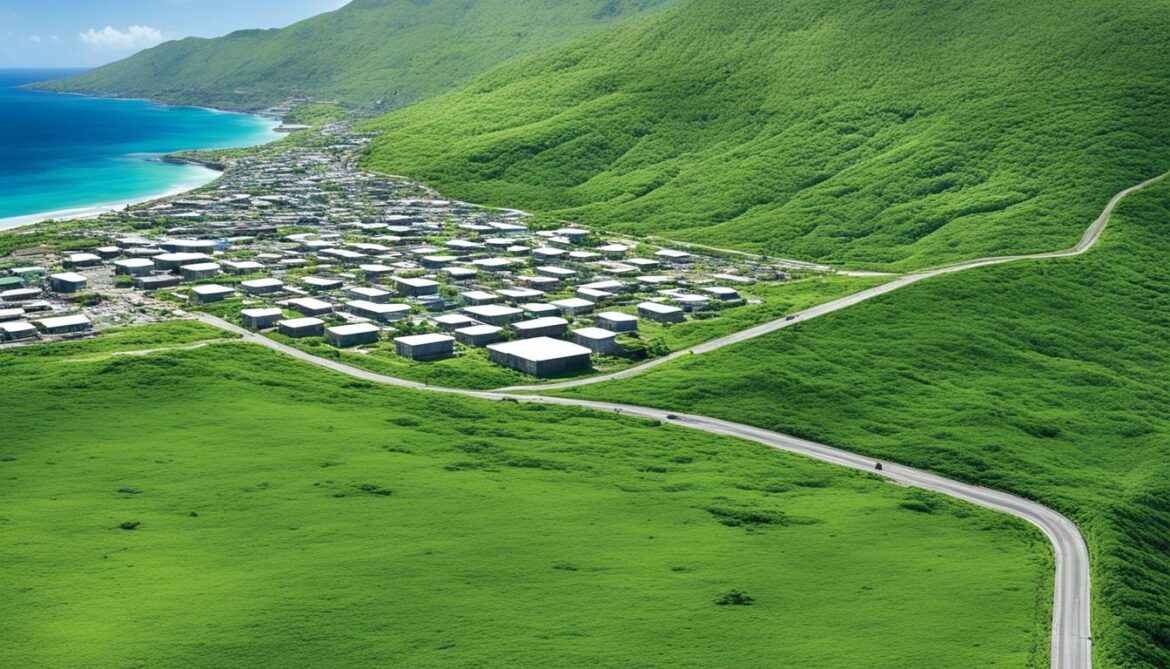
| Threats to Biodiversity in Saint Kitts and Nevis |
Impacts on Biodiversity |
| Habitat loss |
Reduced available space and resources for species, leading to population declines and potential extinctions. |
| Invasive species |
Disruption of native ecosystems, threat to endemic species, and alteration of natural processes. |
| Climate change |
Shifts in species distribution, alteration of habitat suitability, and increased susceptibility to environmental stressors. |
| Pollution |
Contamination of habitats and water sources, affecting both terrestrial and marine species. |
| Overexploitation |
Unsustainable harvesting of species, leading to population declines and loss of biodiversity. |
Conservation efforts are crucial to mitigate these threats and ensure the long-term sustainability of the unique ecosystems in the country. Through habitat restoration, invasive species management, climate change adaptation, pollution control, and sustainable resource management, Saint Kitts and Nevis can safeguard its biodiversity for future generations.
Specific Threats to Biodiversity in Saint Kitts and Nevis
Various factors contribute to the specific threats facing biodiversity in Saint Kitts and Nevis. These threats arise from demographic changes, socioeconomic factors, market-based influences, inadequate regulations, and habitat destruction.
Demographic Changes
The rapid population growth and urbanization in the country have led to habitat destruction and fragmentation. As more land is developed to accommodate the expanding population, natural habitats are disrupted, endangering the delicate balance of ecosystems.
Socioeconomic Factors
Socioeconomic factors, such as unsustainable agricultural practices and resource extraction, have detrimental effects on biodiversity. These practices contribute to habitat loss and degradation, reducing the availability of suitable environments for numerous plant and animal species.
Market-Based Factors
Market demands for specific species or products can put additional pressure on biodiversity. Unsustainable harvesting or trading practices driven by market demand can lead to overexploitation and the decline of certain species.
Inadequate Regulations
The absence of effective regulations and enforcement mechanisms exacerbates the threats to biodiversity. Without proper guidelines and oversight, harmful activities can continue unchecked, further impacting natural habitats and species populations.
Habitat Destruction
Habitat destruction is one of the most significant threats to biodiversity in Saint Kitts and Nevis. As built environments expand and natural areas are converted for other purposes, crucial biodiversity-rich habitats diminish, ultimately resulting in the loss of numerous plant and animal species.
To protect the unique biodiversity of Saint Kitts and Nevis, it is crucial to address these specific threats through comprehensive conservation strategies, sustainable practices, and strengthened regulations.
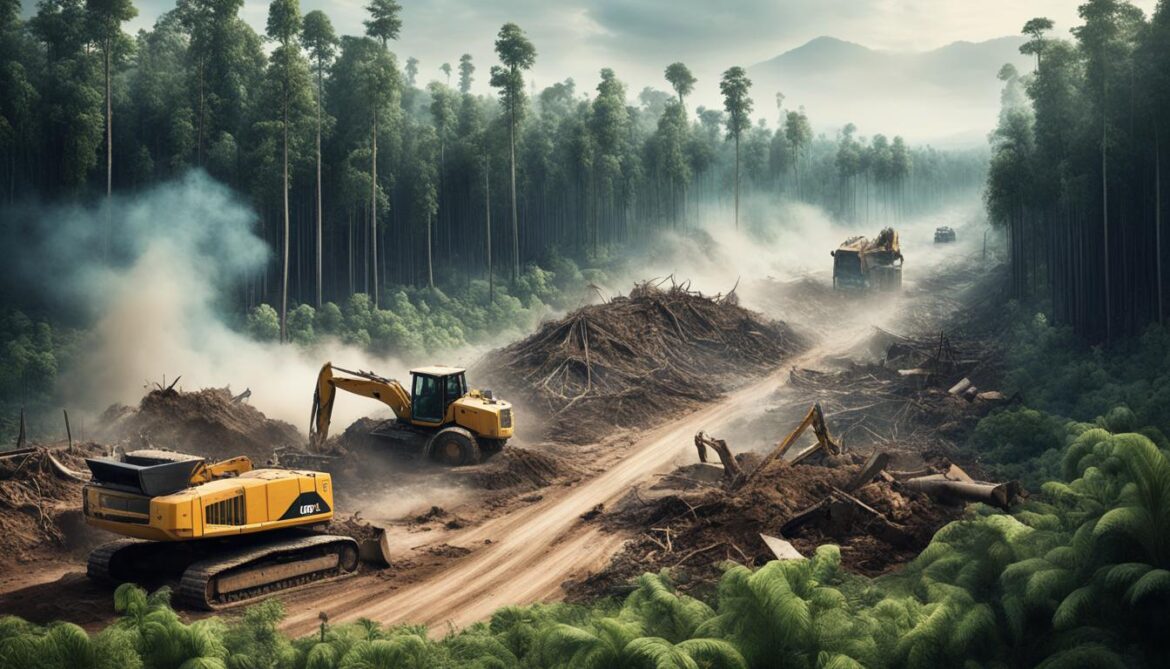
Consequences of Biodiversity Changes
Biodiversity loss has far-reaching consequences for ecosystems and human well-being. When biodiversity is compromised, the functioning of ecosystems is disrupted, leading to a range of negative impacts. This includes reduced resilience, decreased productivity, and increased vulnerability to environmental changes.
Ecosystems provide important goods and services, such as food, clean water, and climate regulation, which are crucial for human survival and development. The disruption of biodiversity can result in a domino effect, affecting the delicate balance of the entire ecosystem.
The reduced resilience of ecosystems makes them more susceptible to disturbances, such as natural disasters and climate change. This, in turn, can lead to a decrease in productivity, impacting agriculture, fisheries, and other industries that rely on ecosystem services. The loss of biodiversity also compromises the natural ability of ecosystems to recover from these disruptions.
“Ecosystems and their biodiversity are the foundation of life on Earth.”
Furthermore, the consequences of biodiversity changes extend beyond the natural world, directly impacting human well-being. The availability of clean water, nutrient cycling, and natural pest control are just a few examples of ecosystem services that support human health and livelihoods.
Without the preservation of diverse ecosystems, we risk diminishing the very resources that sustain us. Protecting and restoring biodiversity is not only crucial for the health and stability of ecosystems but also vital for ensuring the well-being and prosperity of human societies.
For a visual representation of the consequences of biodiversity changes, refer to the table below:
| Consequences |
Description |
| Ecosystem disruption |
Disruption of ecological processes and interactions, leading to imbalances and potential collapse of ecosystems. |
| Reduced resilience |
Decreased ability of ecosystems to withstand and recover from disturbances, making them more vulnerable to external pressures. |
| Decreased productivity |
Reduction in the capacity of ecosystems to provide goods and services essential for human well-being, such as food, timber, and clean water. |
| Human well-being |
Adverse effects on human health, livelihoods, and overall quality of life due to the loss of ecosystem services. |
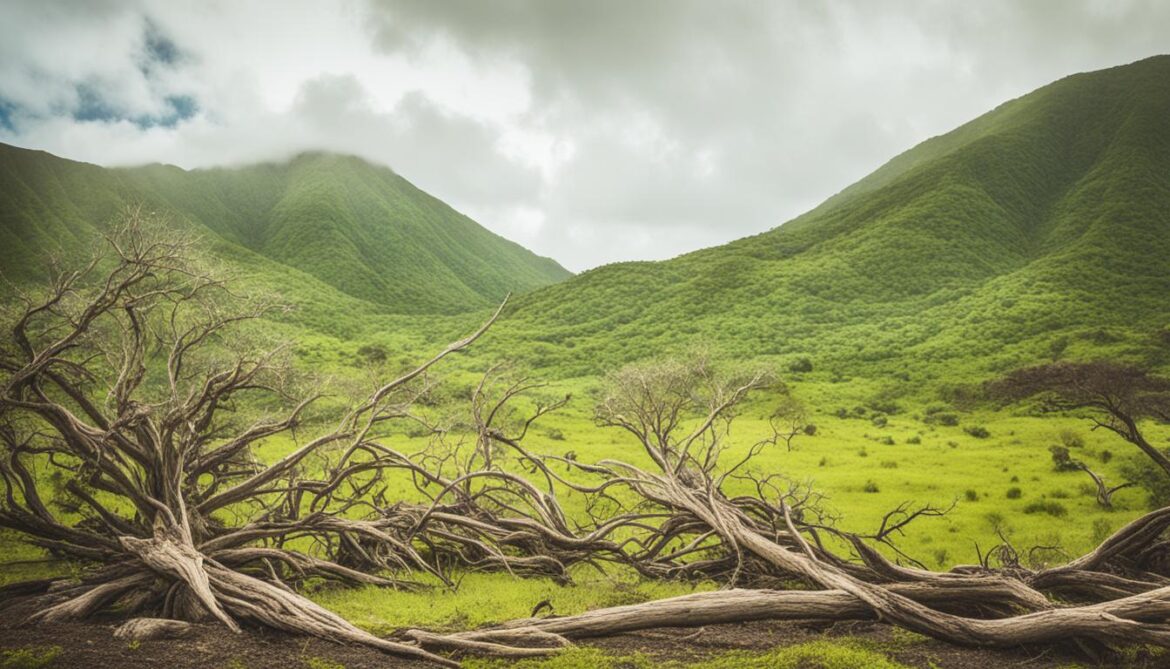
National Biodiversity Targets and Conservation Efforts
Saint Kitts and Nevis is committed to preserving its unique flora and fauna through national biodiversity targets aligned with the global “Aichi Targets” under the Convention on Biological Diversity’s Strategic Plan. Various initiatives have been implemented to protect and preserve biodiversity in the country, including poverty reduction programs, agricultural diversification projects, and environmental management strategies. Efforts are also being made to set up protected areas and promote sustainable development practices that prioritize biodiversity conservation.
One of the key strategies in achieving national biodiversity targets is the integration of sustainable development practices. By aligning economic growth with biodiversity conservation, Saint Kitts and Nevis aims to create a balanced approach that ensures the long-term sustainability of its ecosystems. This approach recognizes the interconnectedness of biodiversity and human well-being, as well as the importance of preserving natural resources for future generations.
“Sustainable development is the pathway to the future we want for all. It offers a framework to generate economic growth, achieve social justice, exercise environmental stewardship, and strengthen governance.” – United Nations Secretary-General Ban Ki-moon
By implementing poverty reduction programs, Saint Kitts and Nevis aims to address the root causes of biodiversity loss. These programs focus on improving livelihoods and providing alternative income opportunities that promote sustainable practices. By reducing poverty, the country aims to alleviate pressure on natural resources and create a more harmonious relationship between human communities and the environment.
Another important aspect of conservation efforts in Saint Kitts and Nevis is environmental management. The country has implemented strategies to enhance environmental governance and ensure the effective management of natural resources. This includes the development of policies, regulations, and monitoring systems that promote sustainable resource use and habitat protection. Through these efforts, the country aims to mitigate the negative impacts of human activities on biodiversity and promote responsible environmental stewardship.
National Biodiversity Targets and Conservation Efforts
| Effort |
Description |
| Poverty reduction programs |
Initiatives aimed at improving livelihoods and reducing dependence on unsustainable resource practices. |
| Agricultural diversification projects |
Efforts to promote sustainable farming practices, reduce reliance on monoculture, and protect natural habitats. |
| Protected areas |
The establishment of protected areas to safeguard critical habitats and provide refuge for threatened species. |
| Sustainable development practices |
Integration of sustainability principles into development plans and policies to balance economic growth and biodiversity conservation. |
| Environmental management strategies |
Development and implementation of policies, regulations, and monitoring systems to ensure responsible resource use and habitat protection. |
Through these national biodiversity targets and conservation efforts, Saint Kitts and Nevis is taking important steps towards safeguarding its rich natural heritage. By valuing and protecting biodiversity, the country strives to create a sustainable future that balances development with environmental preservation.
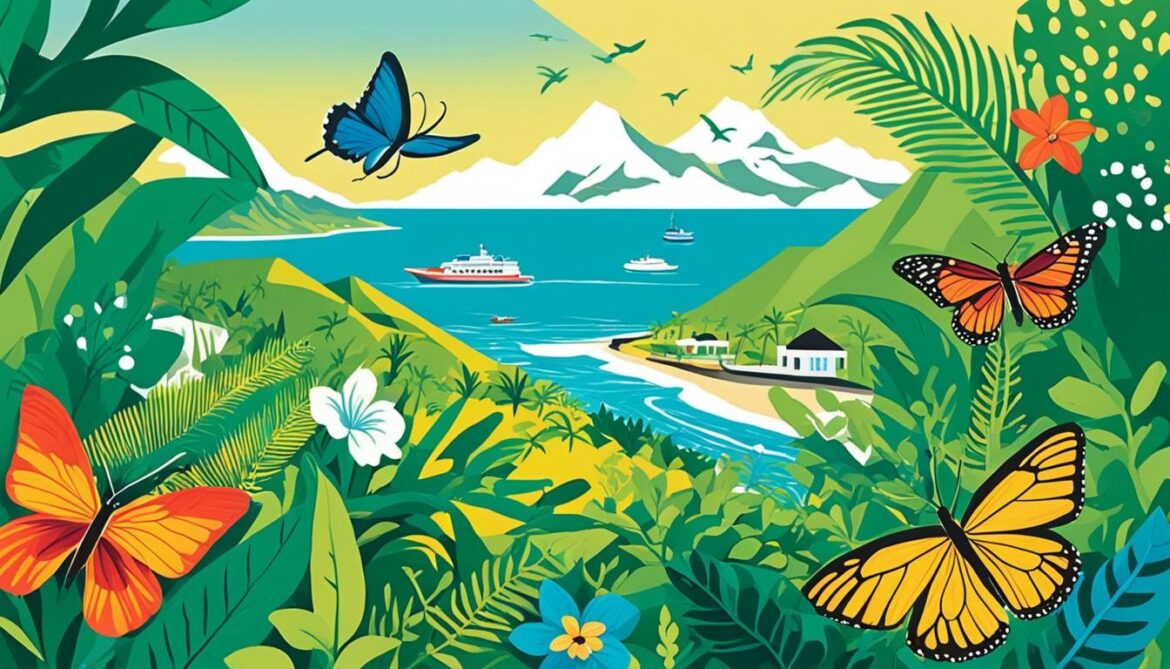
Marine Biodiversity in Saint Kitts and Nevis
The marine biodiversity in Saint Kitts and Nevis is a critical component of the country’s natural heritage. The stunning coral reefs, including the beautiful Sandy Point Reef, are under threat from pollution, overfishing, and climate change, endangering the delicate balance of these underwater ecosystems.
Efforts are being made to establish marine protected areas to safeguard these fragile ecosystems and ensure their long-term survival. These protected areas help regulate human activities and protect the diverse flora and fauna that depend on the coral reefs.
Sea turtles, such as the Green Turtle, Hawksbill Turtle, and Leatherback Turtle, are also a significant focus of conservation efforts in Saint Kitts and Nevis. These majestic marine creatures are considered endangered species and are in need of protection to ensure their populations can thrive.
Special programs have been implemented to monitor and protect sea turtle nesting sites, reduce threats from human activities, and raise awareness about the importance of conserving these marine endangered species.
To fully appreciate the marine biodiversity in Saint Kitts and Nevis, take a closer look at the image below, showcasing the stunning coral reefs and the fascinating sea turtles that inhabit these enchanting waters.
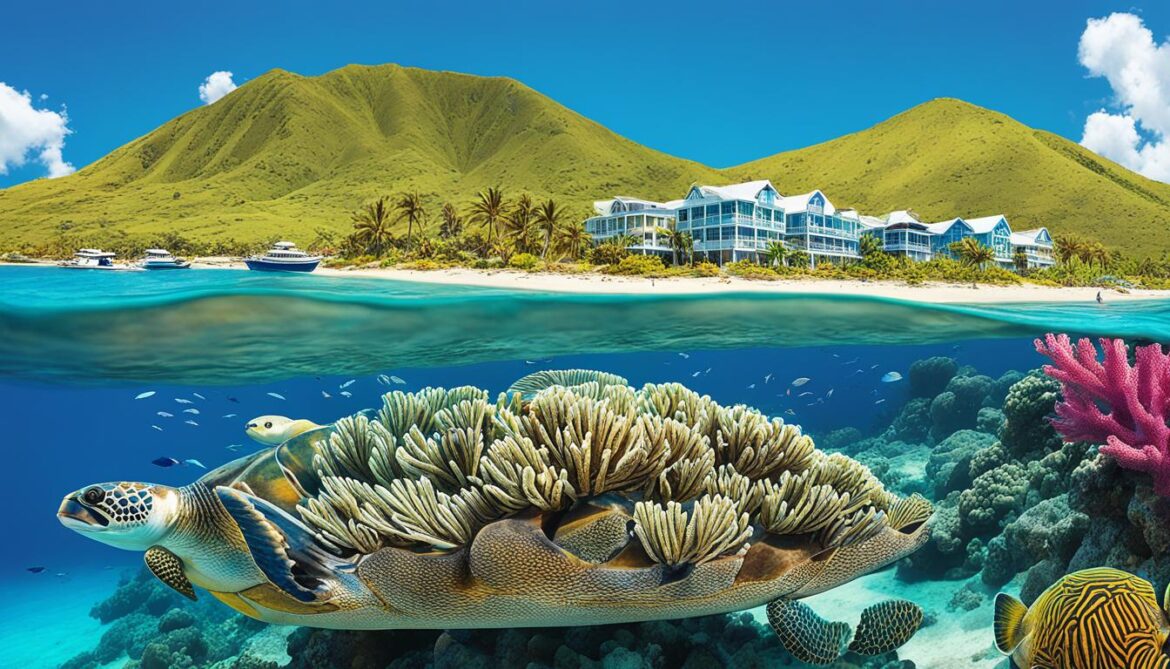
Invertebrates and Freshwater Biodiversity
Although there is limited information on invertebrates in Saint Kitts and Nevis, these often overlooked creatures play a vital role in the country’s ecosystems. In fact, invertebrate fauna greatly outnumber vertebrate animals in terms of species diversity, underscoring their significance in maintaining ecosystem health and balance.
In addition to the diverse array of invertebrates, Saint Kitts and Nevis is home to various species of freshwater fish. These fish species, some of which are endemic to the region, contribute to the country’s unique freshwater biodiversity.
To effectively conserve and protect these vital components of the ecosystem, comprehensive biodiversity assessments are essential. These assessments provide valuable insights into the distribution, abundance, and ecological importance of invertebrates and freshwater fish species. By understanding their habitats and ecological requirements, conservation efforts can be targeted to ensure the preservation of these valuable species and their habitats.
Importance of Biodiversity Assessments
Biodiversity assessments serve as crucial tools for understanding the current state of invertebrates and freshwater fish species in Saint Kitts and Nevis. They provide valuable data that can help identify threatened species, pinpoint areas of high biodiversity, and guide conservation strategies. Through these assessments, scientists and conservationists can gain insights into the ecological roles and potential vulnerabilities of these species, forming a foundation for effective conservation planning and decision-making.
“Biodiversity assessments are essential in uncovering the hidden treasures within Saint Kitts and Nevis’ ecosystems, shed light on the delicate interplay between species, and provide a roadmap for conservation efforts.” – Environmental Scientist Jane Williams
Biodiversity Assessment Methods
Biodiversity assessments employ various methods to gather data on invertebrates and freshwater fish species. These may include:
- Surveys: Field surveys involve direct observations, specimen collection, and habitat assessments to identify and document species diversity in specific locations.
- Sampling Techniques: Sampling methodologies such as pitfall traps, sweep nets, and aquatic sampling gear can help capture and identify invertebrates and freshwater fish species in different habitats.
- Genetic Analysis: DNA analysis techniques can provide insights into species identification, genetic diversity, and population structures, particularly for cryptic or closely related species.
Combining these methodologies allows scientists to collect comprehensive data on the invertebrates and freshwater fish species found in Saint Kitts and Nevis.
Example of Biodiversity Assessment: Freshwater Fish Species Inventory
An example of a biodiversity assessment in Saint Kitts and Nevis is a freshwater fish species inventory, conducted by the National Environmental Research Program (NERP). This inventory aimed to identify and document the diversity of freshwater fish species and their distribution in the country’s rivers, streams, and wetlands.
| Freshwater Fish Species |
Status |
Endemicity |
| Molly Fish (Poecilia sp.) |
Common |
No |
| Mount Scenery Gudgeon (Sicydium sp.) |
Endangered |
Yes |
| Mountain Cichlid (Nandopsis sp.) |
Rare |
No |
| Narwhal Killifish (Fundulus sp.) |
Common |
No |
Table: Freshwater fish species inventory in Saint Kitts and Nevis, showcasing the status and endemicity of selected species. The inventory helped in understanding the distribution and conservation needs of these freshwater fish species.
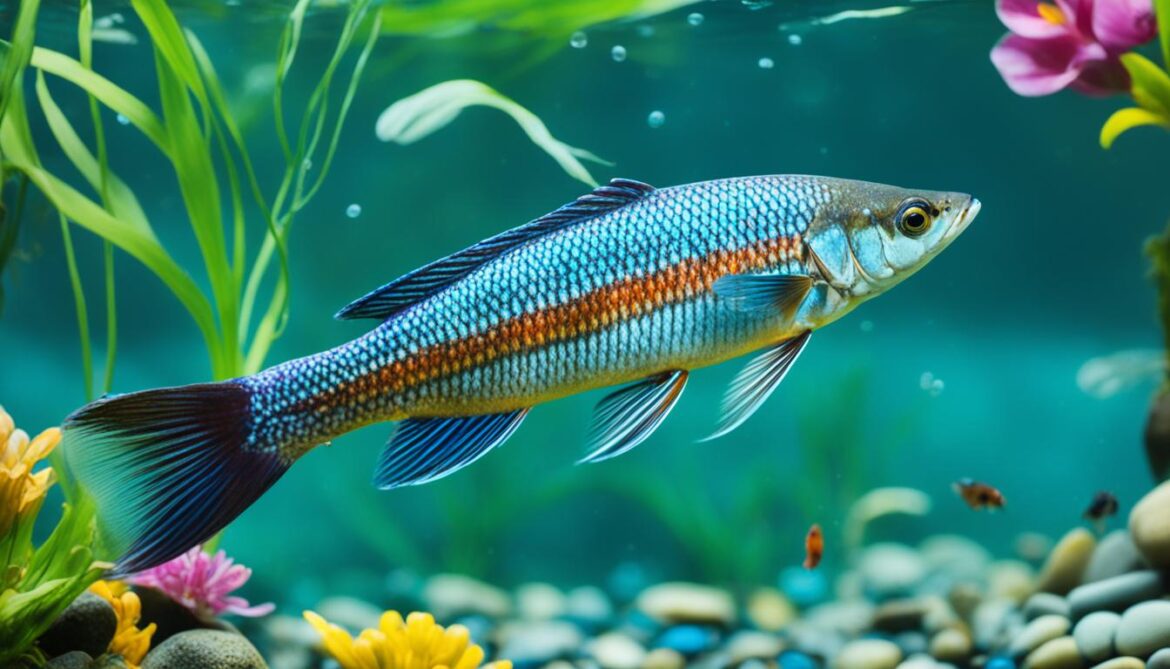
The freshwater fish species inventory provided valuable insights into the status and endemicity of various species. It highlighted the presence of endangered, rare, and common species, some of which are endemic to Saint Kitts and Nevis. This information is essential for conservation efforts and developing targeted strategies to protect these species from further decline.
Pressures on Biodiversity and Conservation Measures
The biodiversity of Saint Kitts and Nevis is under severe pressure from a combination of factors, including private land ownership, climate change, invasive species, an unsustainable resource base, pollution, recreational pressure, and human disturbance.
Private land ownership poses challenges to biodiversity conservation as it can lead to habitat destruction and fragmentation. The conversion of natural habitats into urban areas and agriculture reduces the available space for wildlife and disrupts ecological connectivity.
Climate change exacerbates the threats to biodiversity in Saint Kitts and Nevis. Rising temperatures, sea-level rise, increased storms, and altered rainfall patterns affect the distribution and abundance of species, impacting their survival and ability to thrive in their natural habitats.
Invasive species pose a significant threat to native plants and animals. These non-native species can outcompete local species for resources, disrupt ecosystems, and drive native species to extinction.
An unsustainable resource base, including unsustainable fishing practices and deforestation, negatively impacts biodiversity. Overexploitation of natural resources depletes populations, disrupts food chains, and disturbs ecological balance.
Pollution, such as water pollution from untreated wastewater and agricultural runoff, poses a threat to aquatic ecosystems and the species that rely on them. Pollution can lead to the degradation of habitats, contamination of food chains, and reduction in biodiversity.
Recreational pressure, including tourism and outdoor activities, can result in habitat disturbance and destruction. Increased human presence in fragile ecosystems can displace wildlife, disrupt breeding activities, and impact fragile habitats.
To counteract these pressures and protect biodiversity, conservation measures are being implemented in Saint Kitts and Nevis. Sustainable land use planning aims to balance development with conservation, ensuring that natural areas are preserved for future generations.
Protected area establishment is crucial for safeguarding critical habitats and ensuring the long-term survival of key species. By designating protected areas, governments can provide legal protection to ecologically sensitive sites and implement measures to regulate human activities within them.
Biodiversity-focused regulations are being introduced to promote sustainable practices and ensure that human activities do not harm sensitive ecosystems. These regulations may include restrictions on land use, fishing quotas, and waste management protocols.
In summary, the biodiversity of Saint Kitts and Nevis faces numerous pressures, but conservation measures are being implemented to mitigate these threats. By adopting sustainable land use practices, establishing protected areas, and implementing biodiversity-focused regulations, the country aims to balance human development and economic growth with the preservation of its unique biodiversity.
Conclusion
The rich biodiversity of Saint Kitts and Nevis is a valuable asset that must be conserved for the benefit of future generations. Through sustainable development practices, habitat protection, and extensive conservation efforts, the country strives to achieve a delicate balance between economic growth and the preservation of its unique flora and fauna.
In order to ensure the long-term health and sustainability of Saint Kitts and Nevis’ diverse ecosystems, it is crucial for global collaboration to continue in the field of biodiversity conservation. The combined efforts of international organizations, governments, and local communities are essential in safeguarding the natural heritage of the islands.
Preservation of biodiversity not only protects the intricate web of life within the ecosystems but also plays a vital role in sustaining ecosystem services, improving water resources, sequestering carbon, and supporting economic growth. The commitment to ecosystem protection and sustainable development in Saint Kitts and Nevis reinforces the importance of preserving the natural environment for the well-being of both present and future generations.
FAQ
What is the importance of biodiversity at the national level?
Biodiversity plays a crucial role in maintaining ecological balance and providing essential ecosystem services such as clean water, carbon sequestration, and economic opportunities through ecotourism. It also contributes to the overall well-being of a country and its people.
What are the specific threats to biodiversity in Saint Kitts and Nevis?
The threats to biodiversity in Saint Kitts and Nevis include habitat loss and fragmentation due to demographic changes and urbanization, unsustainable agricultural practices, invasive species, climate change, pollution, and inadequate regulations for the development of built environments.
What are the consequences of biodiversity changes?
When biodiversity is compromised, ecosystems become disrupted, leading to reduced resilience, decreased productivity, and increased vulnerability to environmental changes. This can have negative impacts on the provision of important goods and services such as food, clean water, and climate regulation, affecting both nature and society.
What are the national biodiversity targets and conservation efforts in Saint Kitts and Nevis?
Saint Kitts and Nevis has set national biodiversity targets aligned with global goals under the Convention on Biological Diversity. The country is implementing various conservation efforts, including poverty reduction programs, agricultural diversification projects, environmental management strategies, establishment of protected areas, and promotion of sustainable development practices.
What is the status of marine biodiversity in Saint Kitts and Nevis?
The marine biodiversity in Saint Kitts and Nevis is a critical component of the country’s natural heritage. Coral reefs, such as the picturesque Sandy Point Reef, are under threat from pollution, overfishing, and climate change. Efforts are being made to establish marine protected areas and protect endangered marine species like sea turtles.
What is the significance of invertebrates and freshwater biodiversity in Saint Kitts and Nevis?
Invertebrates, despite being less known, play a crucial role in ecosystems and significantly outnumber vertebrate animals. Freshwater biodiversity in the country includes various fish species, some of which are endemic. Biodiversity assessments are crucial to understanding and protecting these often overlooked species and their habitats.
What are the pressures on biodiversity in Saint Kitts and Nevis and what conservation measures are being taken?
Pressures on biodiversity in Saint Kitts and Nevis include private land ownership, climate change, invasive species, unsustainable resource practices, pollution, recreational pressure, and human disturbance. To mitigate these threats, conservation measures such as sustainable land use planning, establishment of protected areas, and biodiversity-focused regulations are being implemented.
How does Saint Kitts and Nevis aim to balance economic growth with biodiversity conservation?
Saint Kitts and Nevis aims to strike a balance between economic growth and biodiversity conservation through sustainable development practices, including habitat protection, conservation efforts, and environmental management strategies. The country recognizes the value of its unique flora and fauna and strives to preserve it for future generations.
What are the global collaborations necessary for biodiversity conservation in Saint Kitts and Nevis?
Continued global collaborations, through knowledge sharing, funding support, and joint research initiatives, are essential for biodiversity conservation in Saint Kitts and Nevis. International cooperation can help address common challenges and ensure the long-term health and sustainability of the country’s ecosystems.
Source Links













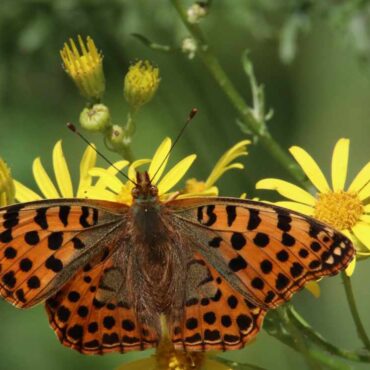
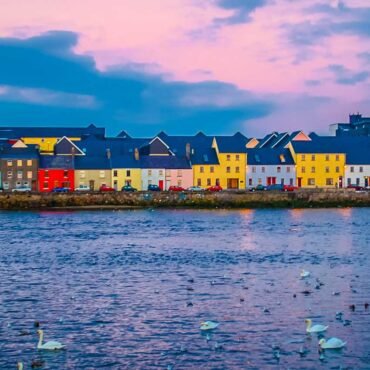









Post comments (0)